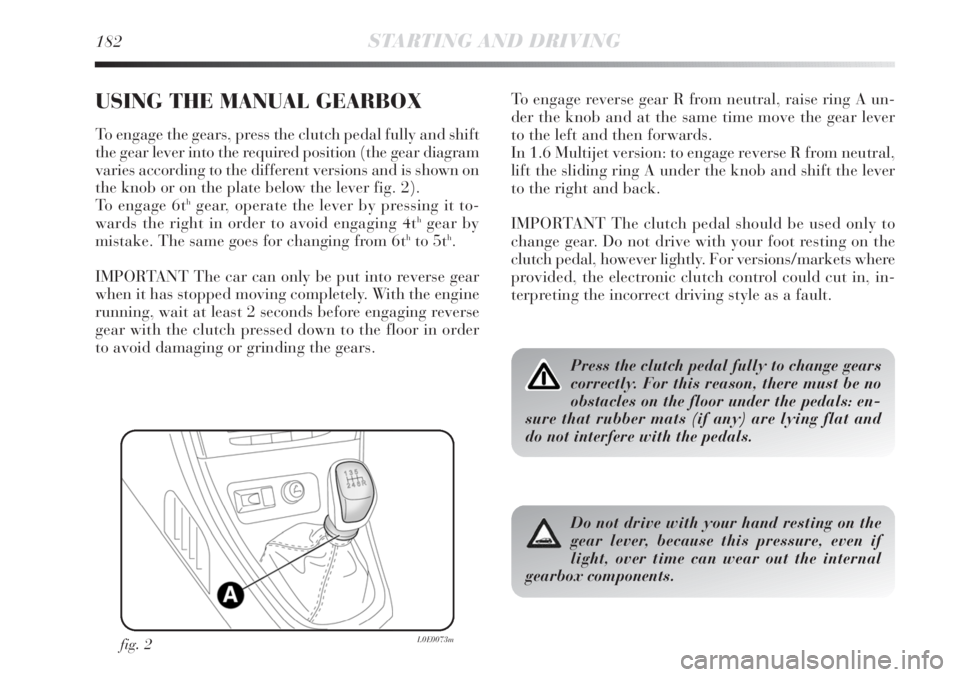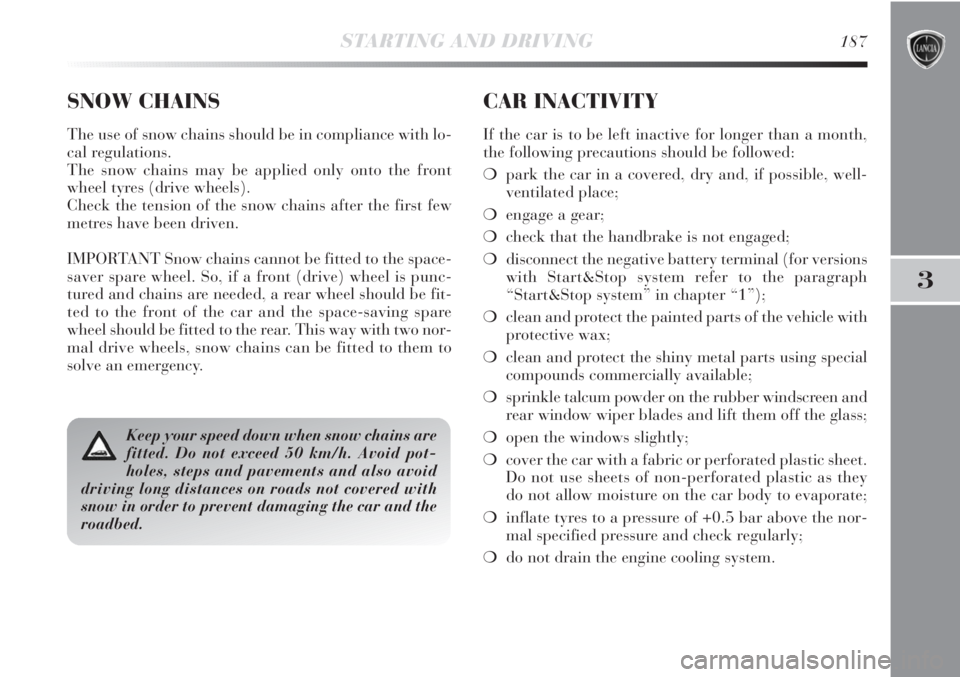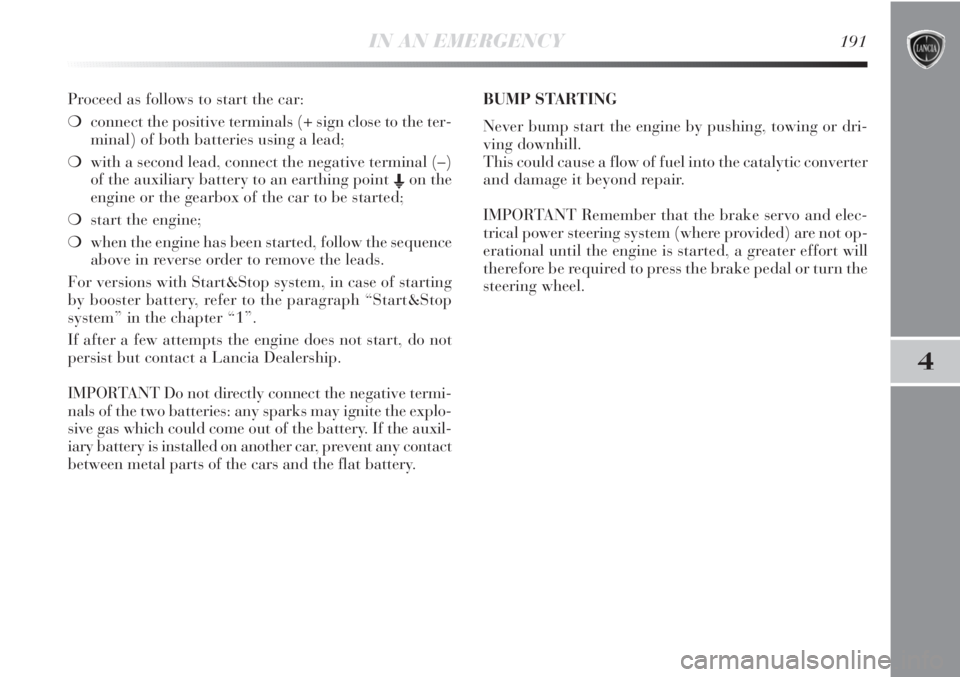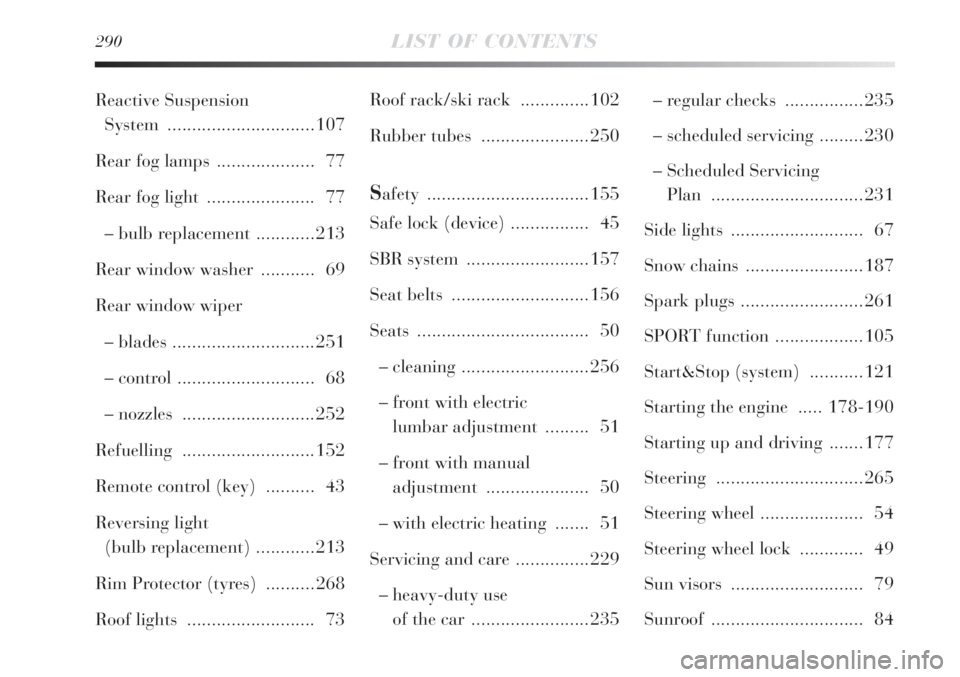stop start Lancia Delta 2013 Owner handbook (in English)
[x] Cancel search | Manufacturer: LANCIA, Model Year: 2013, Model line: Delta, Model: Lancia Delta 2013Pages: 295, PDF Size: 8.29 MB
Page 184 of 295

182STARTING AND DRIVING
USING THE MANUAL GEARBOX
To engage the gears, press the clutch pedal fully and shift
the gear lever into the required position (the gear diagram
varies according to the different versions and is shown on
the knob or on the plate below the lever fig. 2).
To engage 6t
hgear, operate the lever by pressing it to-
wards the right in order to avoid engaging 4thgear by
mistake. The same goes for changing from 6thto 5th.
IMPORTANT The car can only be put into reverse gear
when it has stopped moving completely. With the engine
running, wait at least 2 seconds before engaging reverse
gear with the clutch pressed down to the floor in order
to avoid damaging or grinding the gears.
fig. 2L0E0073m
To engage reverse gear R from neutral, raise ring A un-
der the knob and at the same time move the gear lever
to the left and then forwards.
In 1.6 Multijet version: to engage reverse R from neutral,
lift the sliding ring A under the knob and shift the lever
to the right and back.
IMPORTANT The clutch pedal should be used only to
change gear. Do not drive with your foot resting on the
clutch pedal, however lightly. For versions/markets where
provided, the electronic clutch control could cut in, in-
terpreting the incorrect driving style as a fault.
Press the clutch pedal fully to change gears
correctly. For this reason, there must be no
obstacles on the floor under the pedals: en-
sure that rubber mats (if any) are lying flat and
do not interfere with the pedals.
Do not drive with your hand resting on the
gear lever, because this pressure, even if
light, over time can wear out the internal
gearbox components.
Page 186 of 295

184STARTING AND DRIVING
DRIVING STYLE
Starting
Do not warm the engine with the car at a standstill or at
idle or high speed: under these conditions the engine
warms up much more slowly, increasing electrical con-
sumption and emissions. It is therefore advisable to move
off immediately, slowly, avoiding high speeds: in this way
the engine will warm faster.
Unnecessary actions
Avoid revving up when at traffic lights or before stopping
the engine. The latter action, like double-declutching, is
completely unnecessary and causes increased fuel con-
sumption and pollution.
Gear selection
As soon as the conditions of the traffic and road allow,
use a higher gear. Using a low gear for faster acceleration
will increase consumption.
In the same way improper use of a high gear increases
consumption, emissions and engine wear.
Max. speed
Fuel consumption considerably increases with speed.
Avoiding unnecessary braking and acceleration, which
cost in terms of both fuel and emissions.Acceleration
Accelerating violently will greatly affect consumption and
emissions: acceleration should be gradual.
CONDITIONS OF USE
Cold starting
Short journeys and frequent cold starts do not allow the
engine to reach optimum operating temperature. This re-
sults in a significant increase in consumption levels (from
+15 to +30% on the urban cycle) and emissions.
Traffic and road conditions
Rather high fuel consumption is caused by heavy traf-
fic, for instance when travelling in a queue with frequent
use of low gears or in large towns with many traffic lights.
Mountain and rough roads also have a negative effect on
fuel consumption.
Traffic hold-ups
During prolonged hold-ups (e.g. level crossings) the en-
gine should be switched off.
Page 189 of 295

3
STARTING AND DRIVING187
Keep your speed down when snow chains are
fitted. Do not exceed 50 km/h. Avoid pot-
holes, steps and pavements and also avoid
driving long distances on roads not covered with
snow in order to prevent damaging the car and the
roadbed.
SNOW CHAINS
The use of snow chains should be in compliance with lo-
cal regulations.
The snow chains may be applied only onto the front
wheel tyres (drive wheels).
Check the tension of the snow chains after the first few
metres have been driven.
IMPORTANT Snow chains cannot be fitted to the space-
saver spare wheel. So, if a front (drive) wheel is punc-
tured and chains are needed, a rear wheel should be fit-
ted to the front of the car and the space-saving spare
wheel should be fitted to the rear. This way with two nor-
mal drive wheels, snow chains can be fitted to them to
solve an emergency.
CAR INACTIVITY
If the car is to be left inactive for longer than a month,
the following precautions should be followed:
❍park the car in a covered, dry and, if possible, well-
ventilated place;
❍engage a gear;
❍check that the handbrake is not engaged;
❍disconnect the negative battery terminal (for versions
with Start&Stop system refer to the paragraph
“Start&Stop system” in chapter “1”);
❍clean and protect the painted parts of the vehicle with
protective wax;
❍clean and protect the shiny metal parts using special
compounds commercially available;
❍sprinkle talcum powder on the rubber windscreen and
rear window wiper blades and lift them off the glass;
❍open the windows slightly;
❍cover the car with a fabric or perforated plastic sheet.
Do not use sheets of non-perforated plastic as they
do not allow moisture on the car body to evaporate;
❍inflate tyres to a pressure of +0.5 bar above the nor-
mal specified pressure and check regularly;
❍do not drain the engine cooling system.
Page 193 of 295

IN AN EMERGENCY191
4
Proceed as follows to start the car:
❍connect the positive terminals (+ sign close to the ter-
minal) of both batteries using a lead;
❍with a second lead, connect the negative terminal (–)
of the auxiliary battery to an earthing point E
on the
engine or the gearbox of the car to be started;
❍start the engine;
❍when the engine has been started, follow the sequence
above in reverse order to remove the leads.
For versions with Start&Stop system, in case of starting
by booster battery, refer to the paragraph “Start&Stop
system” in the chapter “1”.
If after a few attempts the engine does not start, do not
persist but contact a Lancia Dealership.
IMPORTANT Do not directly connect the negative termi-
nals of the two batteries: any sparks may ignite the explo-
sive gas which could come out of the battery. If the auxil-
iary battery is installed on another car, prevent any contact
between metal parts of the cars and the flat battery.BUMP STARTING
Never bump start the engine by pushing, towing or dri-
ving downhill.
This could cause a flow of fuel into the catalytic converter
and damage it beyond repair.
IMPORTANT Remember that the brake servo and elec-
trical power steering system (where provided) are not op-
erational until the engine is started, a greater effort will
therefore be required to press the brake pedal or turn the
steering wheel.
Page 198 of 295

196IN AN EMERGENCY
❍if after this operation it is still not possible to reach
at least 1.8 bar after five minutes, do not start driving
since the tyre is excessively damaged and the fast tyre
repair kit cannot guarantee suitable sealing. Contact
a Lancia Dealership;
❍if the tyre reaches the pressure specified in “Cold tyre
pressures” pressure in chapter “6”, start driving im-
mediately;
Apply the adhesive label in a position
clearly visible by the driver as a reminder
that the tyre has been treated with the quick
repair kit. Drive carefully, particularly on bends.
Do not exceed 80 km/h. Do not accelerate and
brake suddenly.
❍after driving for about 10 minutes stop and check the
tyre pressure again; pull up the handbrake;
If the pressure falls below 1.8 bar, do not
drive any further: the quick tyre repair kit
Fix & Go automatic cannot guarantee suffi-
cient hold because the tyre is too damaged. Go to
a Lancia Dealership.
❍if you get a pressure reading of at least 1.8 bar, restore
the correct pressure (with engine running and hand-
brake on) and continue your journey;
❍drive with the utmost care to the nearest Lancia Deal-
ership.
Page 228 of 295

226IN AN EMERGENCY
BATTERY RECHARGING
IMPORTANT The battery recharging procedure is given
as information only. You are advised to go to a Lancia
Dealership to have this operation performed.
Charging should be slow at a low ampere rating for ap-
proximately 24 hours. Charging for a longer time may
damage the battery.
VERSIONS WITHOUT Start&Stop SYSTEM
(for versions/markets, where provided)
Charge the battery as follows:
❍disconnect the negative battery terminal;
❍connect the charger leads to the battery terminals, ob-
serving the polarity;
❍turn on the charger;
❍when you have finished, turn the charger off before
disconnecting the battery;
❍reconnect the negative battery terminal.VERSIONS WITH Start&Stop SYSTEM fig. 43
(for versions/markets, where provided)
To charge, proceed as follows:
❍detach the connector A (by pressing button B) from
sensor C for monitoring the status of the battery in-
stalled on the negative battery pole D;
fig. 43L0E0199m
Page 230 of 295

228IN AN EMERGENCY
When towing, remember that without the
help of the brake servo and electric power
steering, a greater effort is required on the
pedal and steering wheel. Do not use flexible ca-
bles when towing and avoid jerky movements.
While towing, make sure not to damage parts in
contact with the car. When towing the vehicle, it is
compulsory to respect specific highway code reg-
ulations relating to the tow hook and procedures for
towing on the road. Do not start the engine while
towing the car. Before tightening the ring clean the
threaded housing thoroughly. Make sure that the
ring is securely fastened before towing the car.
The front and rear tow hooks must only be
used for emergency situations on the road.
The car may be towed for short distances
when a dedicated device is used in compliance with
the Highway Code (rigid bar), and in order to move
the vehicle on the road in preparation for towing by
a tow truck. Tow hooks MUST NOT be used to tow
vehicles off the road or where there are obstacles
and/or for towing operations using cables or other
non-rigid devices. Respecting the above conditions,
towing must take place with two vehicles (one tow-
ing, the other towed) aligned as much as possible
along the same centre line.
fig. 45L0E0091m
Before towing, turn the ignition key to MAR
and then to STOP without removing it. The
steering column will automatically lock
when the key is removed and the wheels cannot be
steered.
Page 292 of 295

290LIST OF CONTENTS
Roof rack/ski rack ..............102
Rubber tubes ......................250
Safety .................................155
Safe lock (device) ................ 45
SBR system .........................157
Seat belts ............................156
Seats ................................... 50
– cleaning ..........................256
– front with electric
lumbar adjustment ......... 51
– front with manual
adjustment ..................... 50
– with electric heating ....... 51
Servicing and care ...............229
– heavy-duty use
of the car ........................235– regular checks ................235
– scheduled servicing .........230
– Scheduled Servicing
Plan ...............................231
Side lights ........................... 67
Snow chains ........................187
Spark plugs .........................261
SPORT function ..................105
Start&Stop (system) ...........121
Starting the engine ..... 178-190
Starting up and driving .......177
Steering ..............................265
Steering wheel ..................... 54
Steering wheel lock ............. 49
Sun visors ........................... 79
Sunroof ............................... 84 Reactive Suspension
System ..............................107
Rear fog lamps .................... 77
Rear fog light ...................... 77
– bulb replacement ............213
Rear window washer ........... 69
Rear window wiper
– blades .............................251
– control ............................ 68
– nozzles ...........................252
Refuelling ...........................152
Remote control (key) .......... 43
Reversing light
(bulb replacement) ............213
Rim Protector (tyres) ..........268
Roof lights .......................... 73